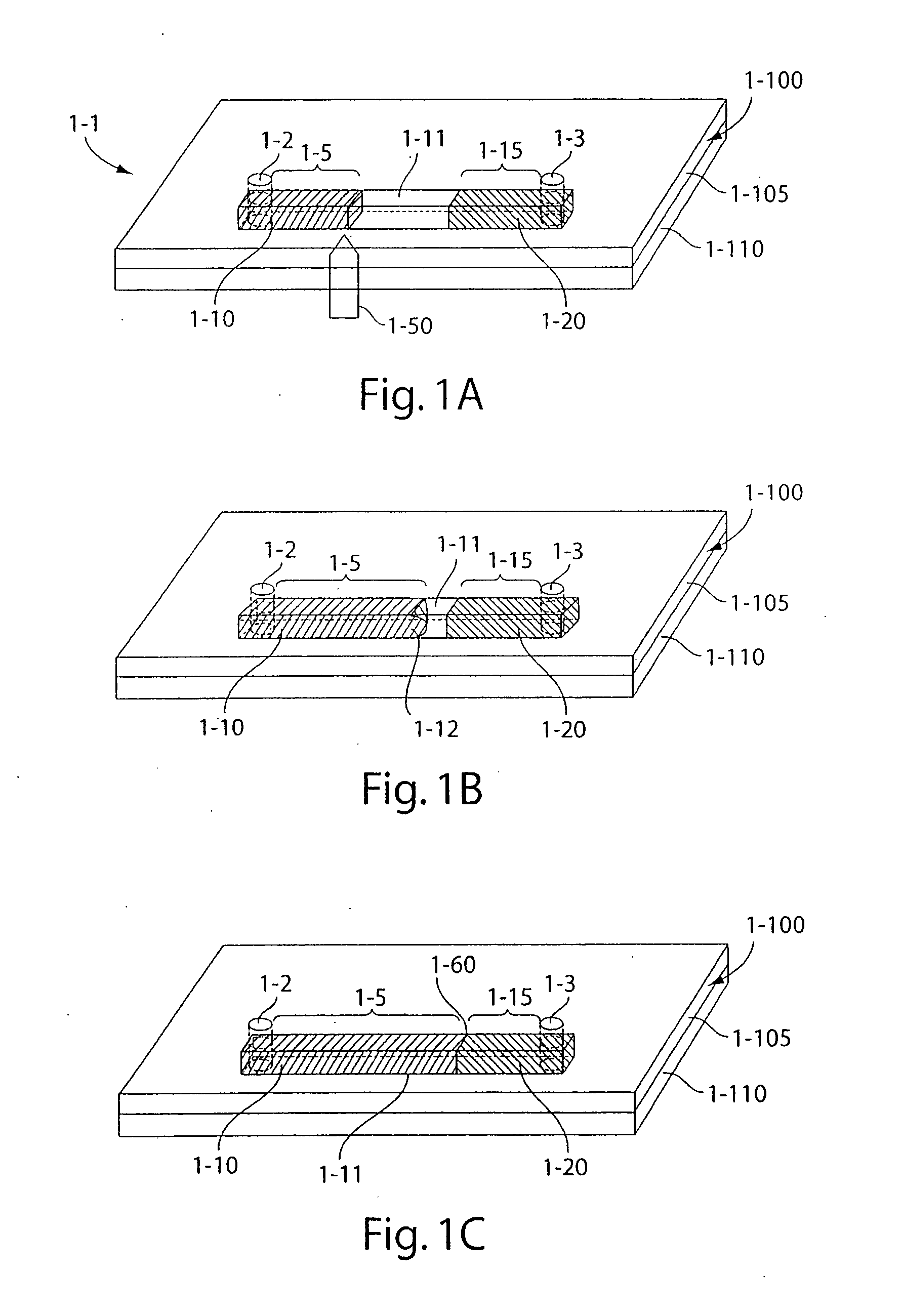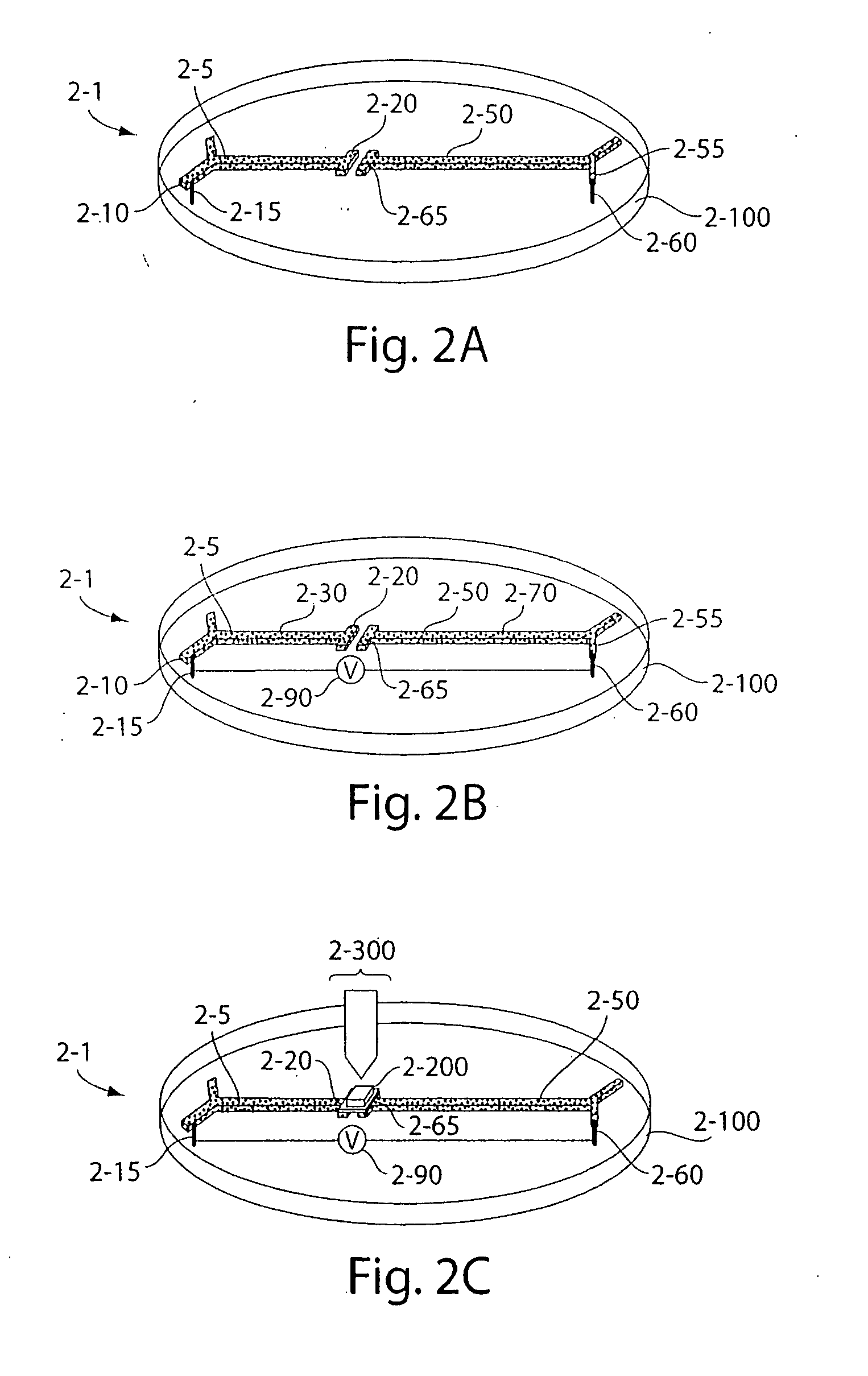Fabrication of conductive pathways, microcircuits and microstructures in microfluidic networks
a technology of microfluidic networks and conductive pathways, which is applied in the direction of microstructural devices, microstructures, microstructures, etc., can solve the problems of undesirable shrinkage of molded metal, difficult to combine and integrate into a single device,
- Summary
- Abstract
- Description
- Claims
- Application Information
AI Technical Summary
Benefits of technology
Problems solved by technology
Method used
Image
Examples
example 1
Fabrication of an LED Device Using a PDMS Microfluidic Structure
[0160]A structure comprising a first and a second microfluidic channel, not in electrical connection with each other, was fabricated using PDMS. The channels were filled with a 0.01 mM solution of octadecanethiol (HS(CH2)17CH3); the solution was then removed from the channels, which resulted in a layer of octadecanethiol deposited on the walls of the channel. This layer of octadecanethiol enabled the walls of the channel to be wetted by a liquid metal in a later step. An LED was placed between the outlets of the two channels such that the terminals of the LED bridged the two channels. The channels were then filled with a clean low-melting solder alloy (e.g., LMA-117; the solder was unoxidized and kept under water at pH 1 prior to use). Once inside the channel, the solder was manipulated from the outside by melting it with a warm soldering iron. The solder was moved and redirected in the channel using the soldering iron....
example 2
Improving Liquid Metal (Solder) Wetting of PDMS Microfluidic Channels Using an Alkanethiol
[0162]This example shows the degree to which a liquid metal (e.g., low-melting solder) wets different walls of a channel depending on the material in which the channel is made and / or the chemical that is patterned on the walls of the channel. Contact angles (in degrees) of 10 microliter (μL) drops of low-melting solder alloy LMA-117 (Small Parts, Inc.) on dry PDMS and glass were measured after washing the surfaces with 10 mM octadecanethiol in ethanol. Each contact angle was measured twice: once immediately after placing the drop on the surface, and again after re-melting the drop briefly (˜70 degrees Celsius, 1 minute) and allowing it to return to room temperature.
TABLE 1Contact angles (degrees) of low-melting solder alloy LMA-117on glass and dry PDMSGlass (clean)PDMSThiolFreshReheatFreshReheatnone145139133123Hexadecanethiol1401311191191-mercapto-undecanoic acid1401359088
example 3
Techniques Used for Fabrication of Conducting Pathways in Microfluidic Structures
[0163]Making Microfluidic Channels in PDMS and Filling Channels with Solder to Form “Microsolidic Structures”
[0164]Microsolidic structures were fabricated according to the procedure illustrated in FIG. 5. In Step A, masters 500 of the lower and upper layers of a network of microfluidic channels were fabricated in SU-8 photoresist (MicroChem, Inc.) 502 on silicon wafers 501 (in bas-relief) using a procedure described previously in U.S. Pat. No. 6,645,432 and in Xia, Y.; Whitesides, G. M. Soft Lithography. Angew. Chem. Intl. Ed. 1998, 37, 550-575; and Duffy, D. C.; McDonald, J. C.; Schueller, O. J. A.; Whitesides, G. M. Rapid Prototyping of Microfluidic Systems in Poly(dimethylsiloxane). Anal. Chem. 1998, 70, 4974-4984. The wafers were silanized with (tridecafluoro-1,1,2,2-tetrahydrooctyl)-1-trichlorosilane overnight. In Step B, freshly prepared PDMS (Sylgard 184, Dow Corning, Inc) was spin-coated on the ...
PUM
| Property | Measurement | Unit |
|---|---|---|
| Temperature | aaaaa | aaaaa |
| Length | aaaaa | aaaaa |
| Length | aaaaa | aaaaa |
Abstract
Description
Claims
Application Information
 Login to View More
Login to View More - R&D
- Intellectual Property
- Life Sciences
- Materials
- Tech Scout
- Unparalleled Data Quality
- Higher Quality Content
- 60% Fewer Hallucinations
Browse by: Latest US Patents, China's latest patents, Technical Efficacy Thesaurus, Application Domain, Technology Topic, Popular Technical Reports.
© 2025 PatSnap. All rights reserved.Legal|Privacy policy|Modern Slavery Act Transparency Statement|Sitemap|About US| Contact US: help@patsnap.com



